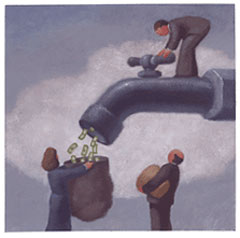Perhaps the only thing tougher than the procurement job itself the challenge of quantifying the value of the effort and investment in the function.
Several years back, SCDigest wrote an article summarizing the views of P. Fraser Johnson and Michiel R. Leenders, of the University of West Ontario and the Richard Ivey School of Business, respectively, on this topic.
Supply Chain Digest Says... |
 |
| In addition to delivering hard- and soft-cost savings, strategic sourcing and procurement teams also drive value by decreasing a company's need for working capital. |
 |
What do you say? |
| Click here to send us your comments |
 |
| Click here to see reader feedback |
|
|
They cited the following challenges in quantifying procurement value:
• System Challenges
• Who Gets the Credit?
• Things Change
• Refusal to Account for Cumulative Savings
• Incomplete Definition of Savings
• Inability to Convert Savings into Profit
• Reluctance to Revisit Past Decisions
That's a pretty good list. To see the details, and what the authors recommend to do about it, go here: The Challenge in Quantifying Savings from Supply Management
We recently found some other interesting thoughts on quantifying procurement value in a recent piece from Harvard Business Review's Analytic Services group, part of a much broader report titled High-Performance Sourcing and Procurement.
Highlights of that section of the report are published below.
On one level, the report notes, quantifying the value of high-performance, strategic sourcing and procurement seems fairly straightforward: in addition to improving operational efficiency - measured through metrics such as decreased cycle times, percentage of on-time payments, and many more - high-performance sourcing and procurement delivers clear cost savings.
In practice, however, the report says, measuring and understanding the value of high-performance sourcing and procurement extends far beyond simply monitoring operational efficiency metrics and identifying cost savings.
HBR says that "When measuring and reporting business impact, sourcing and procurement organizations tend to be conservative - careful not to claim credit for the efforts of their colleagues in the business, and equally careful to validate savings and efficiency gains, often with assistance from the office of finance."
As an example, a sourcing leader at one fast-growing software firm told HBR that "We are conservative in the way we assess savings. We only report the number that sourcing has successfully been able to influence. If our business partners have already been able to negotiate 10% or 20% off, we assess our contribution from there - we don't count what the businesses were able to achieve on their own."
Levi Strauss provides another view on this topic.
"As we've evolved, our definition of savings has evolved with us," said a company procurement executive. "We've gone from simply "a saving is a saving" to "How do we categorize this saving?" What should be categorized as cost avoidance? What qualifies as negotiated savings? What qualifies as hard money that we can free from the budget and redirect to other projects?"
This approach is achieved in part by working closely with the finance team, the executive said.
In addition to delivering hard- and soft-cost savings, strategic sourcing and procurement teams also drive value by decreasing a company's need for working capital.
"Sourcing teams regularly negotiate more favorable payment terms to improve their company's working capital position, but they also contribute to operational improvements that boost working-capital efficiency, for example, by arranging with a supplier to deliver goods on a just-in-time basis, while holding inventory in the supplier's facilities," the report notes.
(See More Below)
|
CATEGORY SPONSOR: SOFTEON |
|
|
| |
|
|
In an interesting example from the report, at building products makers Owens Corning every organization in the global sourcing function measures a "value creation index," which encompasses cash and working-capital metrics such as discounted cash flow, in addition to hard-savings metrics.
The approach has paid off. In 2016, Owens Corning's sourcing team contributed millions of dollars of hard savings to the company, which helped it achieve record levels of adjusted EBIT and free cash flow.
However, some areas impacted by procurement performance are much more difficult to quantify.
 The report observes that quantifying the value of risk avoidance is one area that is notoriously challenging to quantify, noting that many sourcing and procurement groups measure their risk-related performance using operational metrics tied to the execution of risk-management processes. The report observes that quantifying the value of risk avoidance is one area that is notoriously challenging to quantify, noting that many sourcing and procurement groups measure their risk-related performance using operational metrics tied to the execution of risk-management processes.
Also difficult to quantify, the report says, are procurement's contribution to innovation, creative problem solving, and other business outcomes beyond hard dollar savings - contributions that may well be manifested in additional revenues, but not in outright cost reductions.
The report says "narratives" are sometimes used to capture this creation of value.
The report also cites the example of Australia manufacturer Bradken, which only recently started to focus on procurement excellence.
Bradken is now generating impressive returns through its sourcing-improvement efforts, with the company realizing a return of 5 to 10 times every dollar it invests in procurement.
"The potential to drive 400% ROI - or more - through a self-paced, self-driven effort is a big reason why many companies are taking a closer look at sourcing and procurement," HBR says.
Although some dimensions are more straightforward to quantify than others, the concrete financial returns of focused sourcing and procurement efforts are quick to accrue and very easy to identify, according to the report.
"As Bradken's and Owens Corning's results demonstrate, companies that focus on strategic sourcing enjoy not just enhanced profitability, but a range of positive results including improved cash and working-capital performance - results that, in turn, are rewarded by investors," the report concludes.
What are your thoughts on quantifying procurement value? Let us know your thoughts at the Feedback section below.
Your Comments/Feedback
|